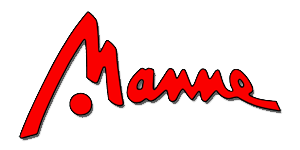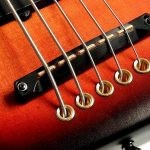Manne Original Ideas
What sets us apart from others? Manne original ideas!
Well, it’s not easy to call oneself an inventor… but we had a very independent evolution by trial and error, so we found out by ourselves the various solutions to problems. Some of our crafted solutions and features reflect this autonomous approach and experimentation.
Multichambers
We ended up into multichambering while trying to solve a few problems. We didn’t realize that there was an unexpected plus, which became evident after we did some trial and errors and we got it right. We initially experimented with multichambering, from our point of view, to reduce weight, like most of other companies do.
Other companies also aim at obtaining a “semiacoustic” tone by routing large cavities. We noticed that a big chamber usually needs to be tuned, and for us this was not good, as it will always lead to some frequencies getting dampened and some others being over emphasized. Many small cavities create many “semiacoustic” systems that avoid the problems of a big single one.
Furthermore, they allow the structure of the body to be more elastic and resonating and the resulting tone can be associated to the one of lighter woods. So we can tune the desired amount of effect according to the body dimensions and wood type, and the desired result. If you lay a hand on the surface of one of these bodies, you can feel how much more they vibrate compared to a solid body. This also leads to a faster maturation of the instrument’s voice.
Fretworks
We’ve developed a not so common technique to put frets into place. We use a resin fretboard (of moderate thickness to avoid too much effect on the overall sound). This resin, unlike wood, is not elastic, so the fret slots are cut with maximum precision on the thickness of the slot to let us place the frets in and glue them with epoxy.
After the frets have been cut and put in place, we clamp the neck with a straight metal block that has the same radius as the fretboard. When it has been placed over the frets, we move it back and forth for a while, so it accommodates at the right position, parallel, and we then clamp it until the epoxy cures.
In this way we can achieve a virtually perfect fret placement, requiring minimal crowning and filing. We usually do this operation before starting to shape the back of the neck, so it is still very straight and cannot be curved. Before this, we work the surface of the fretboard and fret slots at the same time, so when we place the frets we can count on a perfectly straight fretboard surface.
In the first picture you can note the lamination of the neck, the particular shape of the end of bass necks (to keep screws as much apart as possible), and the curvature of the steel block. In the second picture you can notice the unfinished neck with the groove we use for reference to get the right thickness of our necks.
Fretless necks are thicker by the height of a fret (about 1.2mm): the distance from the back of the neck to the top of the strings is the same as in a fretted board.
Neck System: Laminate Neck, Resin Fretboard
Over the years, we always strove to get the neck to perfection: straight, reliable, adjustable and, last but not the least, with consistent tone. Just when you try all possible combinations and you check what you get you know how it works, how sound is affected by components and mechanical features. So in 20 years we worked out a neck recipe we are very proud of. Necks deeply affect the sound of a guitar, much more than you can imagine.
A laminate core gives so much strength to the neck, but with the possibility of carefully controlling the action.
The resin fretboard, limited in thickness to the strictly necessary size, gives consistent and even response to all notes, laying down a fast and non hygroscopic foundation to your playing.
All other makers use phenolic resins associated with other non-wooden materials for the neck, or they use a very thick resin fretboard,6mm or more in thickness.
We developed our own recipe to stay away from the classic glassy and dry sound associated with non-wooden materials:
The fretboard is uncommonly thin (less than 4mm) so it does not affect the tone, which remains woody and natural, absolutely not associable to synthetic materials. So we decided to just take the advantages from it.
We are using maple wings at the sides of the laminate central part for guitars and basses. We found that with the right amount of laminate on necks we could use lighter body woods or multichamber them with a more wide tonal response and improved sensitivity to the playing style.
more on resin fretboard: /manuals-and-tech-specs/?lang=en#resina
Angled Neck
Our necks have an angled lower side, the side that lays on the neck routing in the body of the guitar.
This sets the angle between neck and body perfectly, with no gaps and a perfect contact between neck and body.
No shims under our necks! And no need of dialing the angle as it is perfectly matching with the bridge height.
Even thickness of the fretboard on the side
![]()
Since’98 we build fretboards with a progressive thickness to obtain a constant thickness on the side. Usually fretboard have a reducing thickness on the side due to the different wideness on their lenght.
Guitar Neck-Body Joint
When we started making our proprietary shape, we used to build all neck-through instruments.
One of the benefits of this system was the possibility of having an “all outside of the body” fretboard. When we started working on a set-in neck Taos model, we used to make a wooden tongue that prolongs the neck, allowing the same “outside” positioning of the neck. When the demand for bolt-on instruments increased, we used the same wooden tongue but without having a secure and solid anchorage.
So we set out to develop this system, and in four years we took it to the ultimate perfection. The steel joint is tightly glued and screwed to the neck, so it allows matching the body with the utmost precision, using four metrical threaded screws (so not with common wood screws).
This grants a tight coupling of body and neck, and substantial “mass” is placed at this point which is critical for the transmission of sound.
Strap Pin Location
We placed the upper horn strap pin on the rear side of the body. This is a very small detail, but I never saw the same arrangement on any other instrument. Having the pin in this location forces the instrument, when hanging on the strap, to angle back towards the player, making it lean against the body, giving a feel of stability and “closeness”. I like it very much as it prevents, especially if you are not so thin (diet please), the instrument from flapping around. I think this slight pressure on the body is very warm and gives a good feeling.
Piezo Bridge
We developed this type of bridge to get the best performance out of the piezo. Piezo pickups transform the vibration into an electrical signal tracking the sequence of compressions and releases that the oscillation of the strings causes on the saddles. The more room this “movement” has, the more bass tone you can obtain out of the piezo. That was our goal, to move away from the typical dry and glassy piezo sounds. So we angled the saddles to have them in the center of the angle and have them free from contacts to the bridge, to have the right pressure right onto the piezo. Then, the right sound came from the search for the right thickness and measurements of the top and the underneath chambers. The thickness of the individual saddles follows the curvature of the fretboard with a proper increment towards the lower strings, so the height can easily be adjusted by placing small shims under the bridge.
Piezo Bridge for Solid Body Basses (Basic Piezo)
When we installed the piezo on our solid body bass for the first time, we were not satisfied by the tone we achieved, as it was too thin and bright. So how could we get a better tone? The common answer would be by modifying the electronic circuit, but we do not like electronics so much as we wish to keep it to the minimum.
So we came up with the idea of replicating the mechanics of the great-sounding Acoustibass, with some modifications. We installed the bridge over a bridge plate made of resin. The piezo lays over a zone that can easily vibrate, giving us all the bass frequencies we were looking for. Below you can see the routing on the bass body. The distance from bridge plate and the floor of the routing is filled with rubber as a dampening mechanism. By experimenting with several arrangements and various dimensions we came up with exactly the right tone.
Tone Block for Semiacustica
 We started to develop the Semiacustica model in 1991. On those first models we used to build a very complex neck-through structure with a hollow and larger body. In 1995 we came up with the idea of simulating the mechanics of a semi-acoustic mellow tone by dampening the vibration with a block of rubber. After many prototypes, changing dimensions and materials, we got what we were looking for.
We started to develop the Semiacustica model in 1991. On those first models we used to build a very complex neck-through structure with a hollow and larger body. In 1995 we came up with the idea of simulating the mechanics of a semi-acoustic mellow tone by dampening the vibration with a block of rubber. After many prototypes, changing dimensions and materials, we got what we were looking for.
Vibrations from the strings are absorbed to the right amount, causing a warm jazzy sound, and a good working piezo giving a full sound.
The body is closed and the block is glued to both back and top, so no feedback problems occur, even in loud stage situations.
You can read more about how this works in my vision on tone article.
Better Access Up To the 24th Fret
Our lower horn is wide and there is good access to the 24th fret, but many guitar and bass players have a very “classical” left-hand position. So we decided to take away some more wood just where the hand would touch the body of the guitar. The top and side profiles are untouched, so playing while sitting down gives good comfort too.
Well… thinking about it it’s amazing!!!
It took me more than 20 years to write what you read and learned in 15 minutes!
But there are much more others applied ideas like these in our instruments… i will tell you about them, next time…
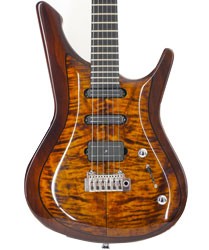
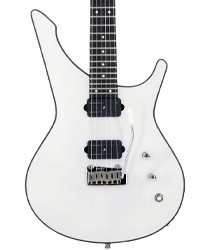
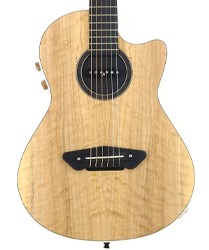
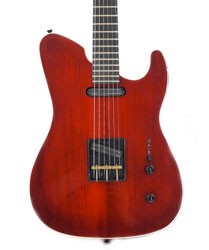
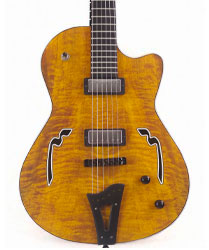

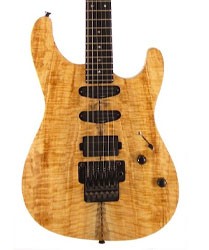

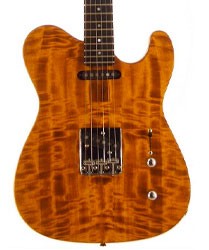
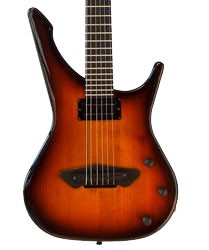
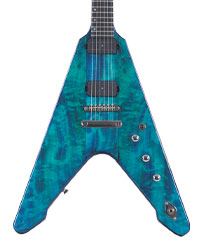

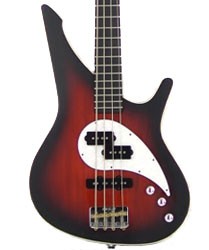
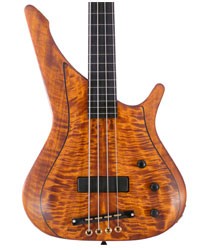

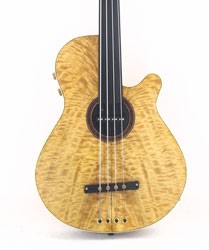
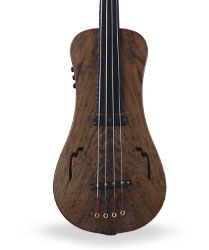

 Italiano
Italiano